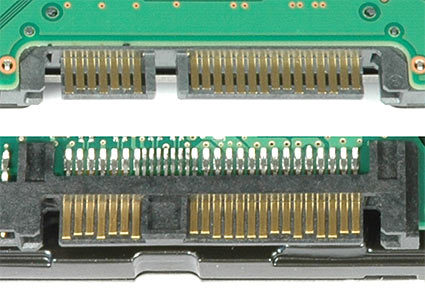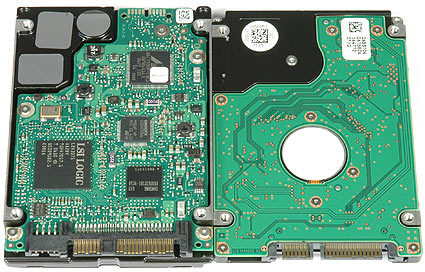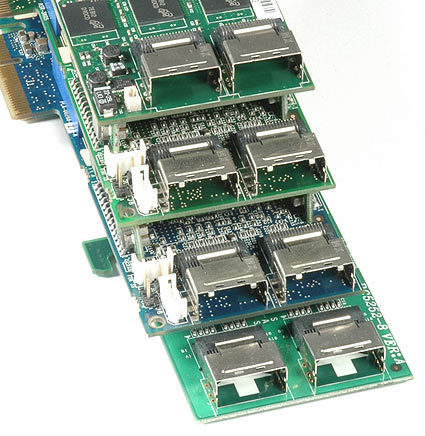Unified Serial RAID Controllers for PCIe
SAS Vs. SATA
Can you tell them apart? The upper connectors are SATA (individual connectors), while the lower one belongs to a Seagate Savvio SAS drive, carrying the continuous connector for data and power.
Both SAS and SATA are based on full-duplex, switched serial point-to-point connections, which means that there is no need to manually assign device IDs or to terminate the connections, and data can be sent and received simultaneously. SAS and SATA also facilitate device hot-plugging. Speeding up parallel protocols such as Ultra320 SCSI either required a wider bus, which requires more wires, or faster clock speeds, which causes problems with signal delays. Serial point-to-point interconnects, however, can simply be bundled. SAS makes use of this technological principle, combining multiple SAS connects to hook up to external appliances.
Mechanically, there is only one difference between SAS and SATA: while both use the same pinout for data and power connections, the two connectors are physically separated for SATA. For SAS, the two connector segments were merged, which makes it possible to attach a SAS drive to a SATA controller using the continuous connector, but you cannot hook up a SAS hard drive to a SATA controller using the SATA connector (SFF 8482).
Performance wise, there is not much of a difference between the two interfaces. Serial ATA 2.5 provides a maximum bandwidth of 3 Gbit/s per port, using an 8/10 bit encoding, which results in a 2.4 Gbit/s or 300 MB/s bandwidth that can be used for actual data. The same applies for SAS, and the roadmap provides a road to 6 and 12 Gbit/s, resulting in 600 MB/s and 1,200 MB/s bandwidth per port.
SAS on the left, SATA on the right hand side.
The Mini SAS 4i connector is used (SFF-8087) to create so-called SAS wide ports, which typically consist of four SAS connections.
Get Tom's Hardware's best news and in-depth reviews, straight to your inbox.
Current page: SAS Vs. SATA
Prev Page Unified Serial Controllers Do SAS And SATA Next Page Drive Trends: 2.5" Moving In
Patrick Schmid was the editor-in-chief for Tom's Hardware from 2005 to 2006. He wrote numerous articles on a wide range of hardware topics, including storage, CPUs, and system builds.
-
Rik ...well,Reply
- Unless RaidCore is trying to peddle their VST Pro software,...aka as Fulcrum proprietary based ? which BTW you said no to, I don't see any advantages here.
Why?, ZFS is free !
And, where are the Drives for Solaris, or the xBSD's , or even MacOSX !!!?
-and still no, becuase their newer 54xx series doesn't support the other 'ix OS's.
Nope, unfortunately, not much to see here.
so, based on the above, Adaptec 5805,... or Areca,... blows this.
-Rikster
-
aapocketz ReplyFor SAS, the two connector segments were merged, which makes it possible to attach a SAS drive to a SATA controller using the continuous connector, but you cannot hook up a SAS hard drive to a SATA controller using the SATA connector (SFF 8482).
I think this paragraph has an error. I believe it should read
For SAS, the two connector segments were merged, which makes it possible to attach a SATA drive to a SAS controller using the continuous connector, but you cannot hook up a SAS hard drive to a SATA controller using the SATA connector (SFF 8482).
In fact I believe the statement should have less emphasis on the connector as its the actual controller that appears to limit the connectivity, the connector is just keyed to allow you to plug SATA drives into SAS but not the other way around.
from wikipedia: "SATA 3.0 Gbit/s drives may be connected to SAS backplanes, but SAS drives may not be connected to SATA backplanes."
I believe the fact that signaling voltages are nearly double on a SAS drive is significant to mention.
Let me know if I am wrong, I just started playing around with a bunch of SAS drives so I am figuring this out as I go.
-
Factors like spindle speed, density, latency etc. effects drive performance as much or more than bandwidth. A 300GB 2.5 15K SAS drive will smoke a 1TB 7200 SATA drive simply because it has about twice the IOPS. The bandwidth is meaningless if you can't get the data on and off the disk at the speed of the bus. Furthermore, except for the WD Velociraptor 10K+ spindle speed drives are non-existent in SATA but are prevalent in SAS. So from an interface standpoint they are very close but SAS drives are really intended for entirely different markets and applications and budgets I might add.Reply
-
Bicom Systems Great article - thanks for the comparison! We also did a piece on SAS and SATA, if you're interested : http://blog.bicomsystems.com/sas-vs-sataReply


